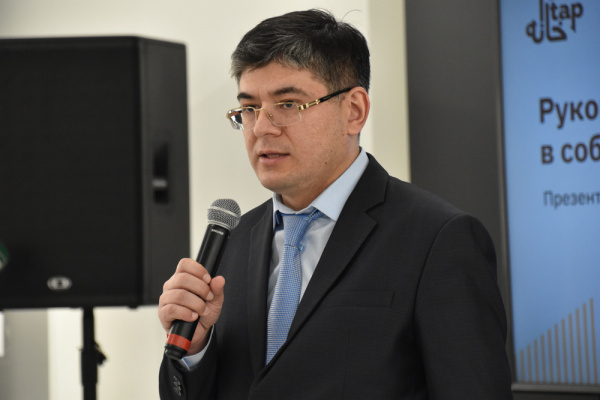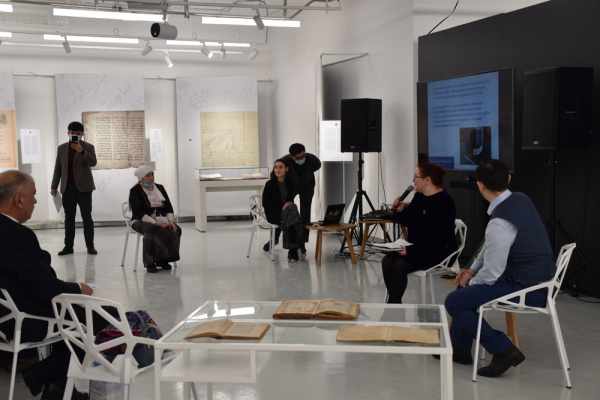Alisher Navoi occupies a special place not only in Uzbekistan, but all over the world. And he is known not only as a poet, but also as a philosopher, a statesman, philanthropist and educator. Today we will talk about Alisher Navoi as a poet and a philosopher.
Last year, the world celebrated the 580th anniversary of the writer’s birth. In Kazan, this day was marked by the publication of the album-catalogue ‘Navoi’s Manuscripts in Kazan’. This work is the first to put the treasures of the world literature and philosophical thought preserved in Kazan and the Volga region into the global scientific and cultural context. Ilya Zaitsev, Doctor of History and Deputy Director General of the State Museum of Oriental Studies, was involved in compiling, prefacing and describing the manuscripts. The National Library of the Republic of Tatarstan, the Kazan Federal University Scientific Library named after N.I. Lobachevski and the National Archives of the republic of Tatarstan took part in the preparation of the compilation.
It is noteworthy that the Kazan lists of the great poet’s works have not been studied before. These manuscripts come not only from Central Asia, but many of them were copied in the Volga region. Among them there is the poet’s Diwan unique manuscript (rewritten in the XVI and XVIII centuries), Pyateritsa manuscript (XVI century), as well as his poems in various poetry compilations of the XVII-XIX centuries.
Alisher Navoi and his timeless genius
Alisher Navoi is no stranger to Russia and to the Tatars in particular as a poet and thinker. In many ways he and his work symbolize close historical ties between Central Asia and Muslim peoples of the Russian Federation.
Alisher Navoi’s works are vast. The volume of his six poems is about 60 000 lines. In 1483-1485 Navoi wrote ‘Khamsa’ (‘Pyateritsa’) consisting of the following poems: ‘Hayrat al-abrar’ (‘Tumult of the Righteous’), ‘Farhad and Shirin’, ‘Layla and Majnun’, ‘Sab’ai Sayyar’ (‘Seven Planets’), ‘Saddi Iskandari’ (‘The Wall of Iskander’). All of them were created on the basis of khamsa tradition – creation of pyateritsa (five poems). Navoi’s ‘Khamsa’ is the first work of this genre composed in the Turkic language.
Throughout his creative life, Navoi managed to try his hand in almost all popular genres of Muslim Oriental literature without losing his own voice and style.
Apart from expressing and interpreting human and Sufi love in his poems, Alisher Navoi also addresses everyday worldly problems that break through the poet’s humanistic outlook. For instance, in the poems ‘Seven Planets’ and ‘The Wall of Iskander’ problems related to the throne come to the fore. The poet spoke through his lines about the impermanence of the world and the duties of a ruler to his people.
In its public and artistic significance, Navoi’s ‘Khamsa’ had a great place in Central Asia. It has been copied extensively. There are now many copies of ‘Khamsa’ around the world. This is a vivid testimony to the role this work played in the lives of Central Asia.
During his prolific life, Navoi managed to create a great number of lyrical works. In 1498 he completed a compilation of all his poems and created four Diwan-collections called ‘Khazain al-maoni’ (‘The Treasury of Thought’). He compiled poems written in Persian into the collection called ‘Diwani Fani’.
In addition to artistic sketches, Navoi wrote scientific works. They include works on comparison of Persian and Turkic languages – ‘Mukhamat al-lugatayn’ (‘The Dispute of the Two Languages’, 1499), on literary studies – ‘Majalis al-Nafais’ (‘The Collection of the Refined’), on the theory of aruz (verse size) – ‘Mezan al-avzan’ (‘The Balance of Sizes’) and on the theory of muamma genre – (charade) ‘Mufradat’.
He was also interested in history and even wrote treatises on history called ‘Tarikhi Muluki Ajam’ (‘The History of Iranian Kings’), ‘Tarikhi Anbiya Wa Hukama’ (‘The History of Prophets and Sages’). He compiled his artistic letters into a collection called ‘Munshaat’. Also during his lifetime, the Uzbek thinker managed to write a few memoirs, which include the life of Abd Ar-Rahman Jami ‘Khamsat al-mutahayyirin’ (‘The Fivefold Controversy’, 1494), ‘Khalati Sayyid Hasan Ardasher’ (‘The Life of Sayyid Hasan Ardasher’), ‘Khalati Pakhlavan Muhammad’ (‘The Life of Pakhlavan Muhammad’).
Navoi’s most recent work is ‘Mahbub al-kulub’ (1500), which expresses his most recent views on society and politics.
All his life, Alisher Navoi combined his creativity with political activities. As a man of high repute, he made a significant contribution to the improvement of the country’s social and economic life and promoted science, art and literature.
Kazan’s first ever catalogue of Alisher Navoi’s manuscripts

According to Fariddin Nasriev, the Consul General of Uzbekistan, interest in Alisher Navoi’s work and persona grows every year. This is evidenced by the fact that in his native Uzbekistan there is a city and a region, streets and avenues named after him, while outside the Republic monuments are erected and his activities as a thinker and statesman are honored.

According to Ilya Zaytsev, the compiler of the catalogue, Deputy Director of the State Museum of Oriental Art, Alisher Navoi’s texts have not lost their relevance to this day.
‘As far as the catalogue itself is concerned, it is a collective painstaking work. Everybody has contributed their own thoughts and ideas to its creation. It is worth noting that the study of Navoi’s work has a long history in the country. The first book about him was published more than 150 years ago and was a candidate dissertation on Navoi as a statesman. Soviet historian Semyon Volin was the first to directly address his manuscripts and other works. In 1941, he prepared for publication a compilation of manuscripts that were kept in the collections of Leningrad. Due to certain complicated circumstances, the work got printed only in 1946. His idea of putting together the diwan of Alisher Navoi, the stages that the diwan underwent, with some adjustments, is still valid today,’ Zaytsev explained.
Interestingly that despite the richness of Alisher Navoi’s manuscripts in Moscow and Kazan almost no attention has been paid to these two cities. Only one Kazan diwan has been mentioned in one of the scientific works. And this happens even despite the huge readership interest on the part of the Russian Muslims, who not only read Navoi’s works, but also rewrote, reprinted and studied them in detail.
‘This is how we decided to create a catalogue that would include a collection of manuscripts from Kazan. Kazan has always been one of the centres of national orientalism, orientalist thought has been thriving here and excellent books have been published. Kazan can rightly be considered to be a world-class centre. All this could not but have an impact on its manuscript collections. In Kazan these manuscripts are kept at the National Library, the Kazan Federal University Scientific Library named after N.I. Lobachevski and the National Archives. And our catalogue is a great opportunity to get acquainted with these invaluable manuscripts, which were created in different times in different regions and by different people. The only listing of it gives us an insight into how highly Navoi’s work was appreciated,’ the catalogue’s compiler explained.
Two manuscripts date back to the XVI century, one of them to 1568 and it was written in Herat, the birthplace of the great poet. The other three manuscripts are from a later period. One of them was created in 1868, the other two – from no earlier than the XIX century. Each of the five manuscripts was acquired by the library either through a purposeful purchase or through archaeographic expeditions. This was the subject of the presentation by Elmira Amerkhanova, the Head of the Manuscripts and Rare Books Department of the Kazan Federal University Scientific Library named after N.I. Lobachevski.

‘The earliest manuscript is ‘Diwan’ (1568), a compilation of lyrical poems. This manuscript was included in the inventory book of the Oriental Sector of the Manuscripts and Rare Books Department of the Kazan Federal University Scientific Library of the Republic of Tatarstan on 23 May 1939,’ the expert added.
According to Elmira Amerkhanova, another manuscript is unique. Sadretdin, a scribe from Nurlat, compiled a collection of poems by Alisher Navoi for Khamza, the son of Mirza Mukhametgarei Maksudov, a customer from Kasimov in the XIX century.
‘Alisher Navoi is a unique figure among thinkers of the East. His heritage is the greatest value for the Uzbek and other peoples, which is the core of spirituality for the modern generation. This is the reason why the role of Navoi’s works in the spiritual development of nations and ethnicities is increasing. The main task of Navoi studies of our times is to analyze and popularize the works of the thinker in the world oriental studies on the basis of new scientific views and approaches at the time of fundamental changes in society,’ Amerkhanova is convinced.
Regular searches for manuscripts in regions densely populated by Tatars revealed another Navoi’s manuscript, which was described during the presentation of the album-catalogue. In 1968, Khadicha Gilmetdinova from the village of Kayenlyk, Buynsky district, TASSR, gave a copy of a Diwan, created no earlier than the XIX century, to an archaeographic expedition of the Kazan University.
